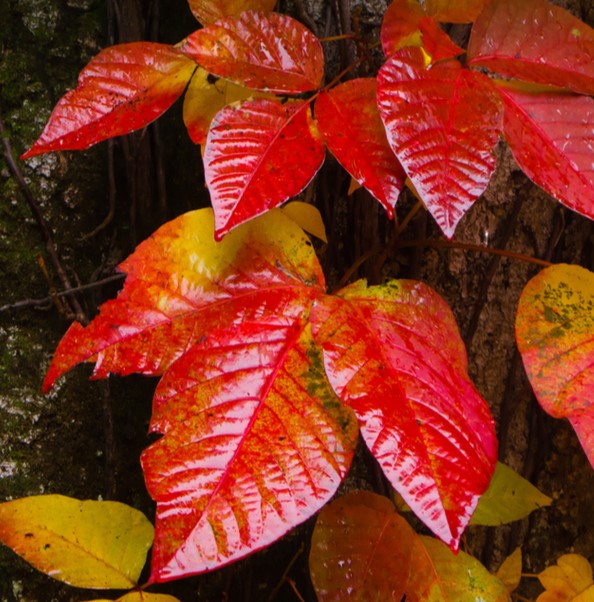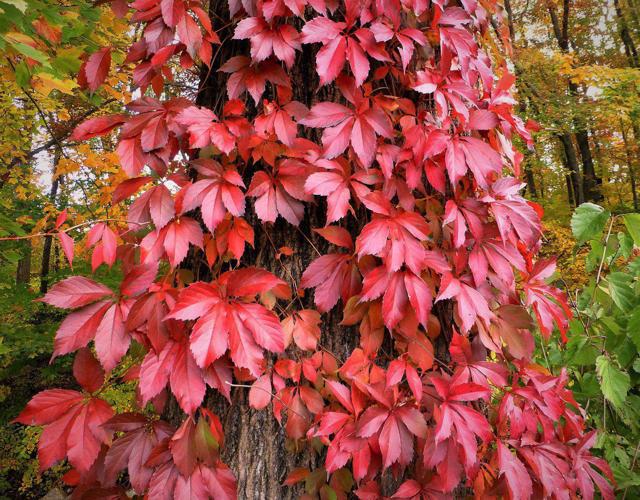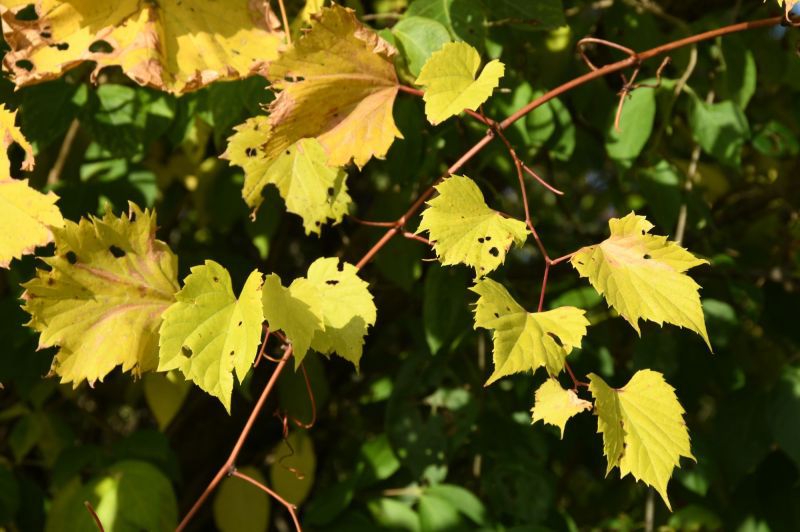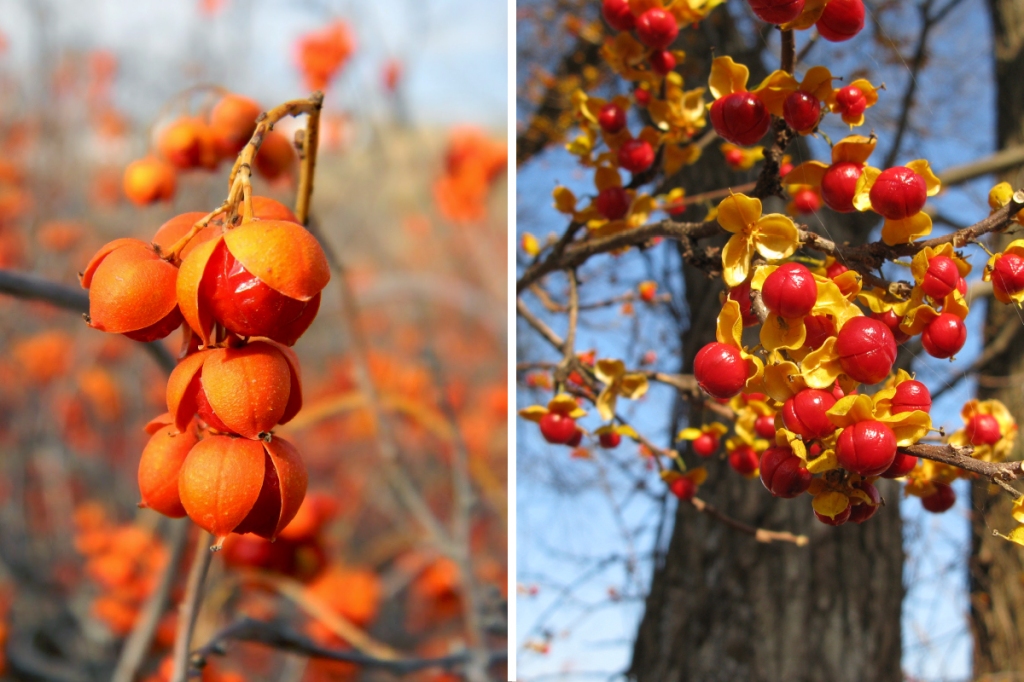
They are the stepchildren of the field and forest, creeping and climbing among the underbrush, up tree trunks, and along sunny fencerows. During most of the year, they go unnoticed, overshadowed by the more stately trees and the wildflowers. Throughout the verdant summer months, their searching tendrils silently grew outward, grabbed hold, and extended their reach towards the life-giving light. In September, though, they blaze forth in varied hues of yellow, orange, and red, providing a sneak preview of autumn’s color show.
As early as August, the shortening days stimulate leaves to forsake their green cloak and reveal the other brightly colored pigments hidden within. These cool fires of autumn begin, appropriately, at the base of trees and the shrubby forest edge, where vines such as poison ivy, Virginia creeper, and wild grape do most of their creeping and climbing. By the time the color appears in the forest canopy, most of the vines have faded and dropped their leaves.
Many people think of vines as plants that smother and strangle other plants. This is not necessarily true. Vines will, at times, smother smaller plants they climb upon by covering the limbs and leaves to such an extent that they rob the host of sunlight. The scourge of the southeastern United States, kudzu, is a good example of this. In most cases, however, they co-exist with their host, gathering a share of the sunlight available in that particular location. Vines put their energy into rapid growth rather than building a sturdy supporting trunk, relying on their host tree for support. Modified leaves, called tendrils, wrap around the host plant’s stems and branches, providing an anchor. Where trees for climbing are few, vines simply creep along the ground searching for any available light.
Poison ivy (Rhus radicans) is the most well known of the vines. Its reputation usually precedes any familiarity with the plant’s appearance and lifestyle. Poison ivy grows in open fields, along fencerows, along stream banks, in sandy soil, on rocky outcrops, on the sides of buildings, and almost anywhere else. Three dark green, often-glossy leaflets joined to a single leaf stem identify poison ivy. The stems and twigs are brown and tend to zigzag somewhat (a growth trait common to many climbing plants). It can appear as a short low-growing plant or as a sprawling many-branched vine climbing high into the treetops. Clusters of white berries appear by early fall.

Unlike many feared things in the natural world, poison ivy’s reputation is mostly deserved. The chemical that causes the infamous itchy rash, urushiol, remains active even after the leaves are gone, indeed, even after the plant is cut down. It occurs as an oil on all parts of the plant—leaves, stems, buds, and berries. What many people do not realize is that the oil is easily washed off the skin or clothing with warm, soapy water, preventing a reaction. This needs to be done as soon after contact as possible. Sensitivity varies among individuals. A few people have severe allergic reactions to it, even so bad as to require emergency medical care. Some people have no reaction at all, though repeated exposures can be cumulative and eventually will cause a reaction. Most people experience a localized, itchy, reddish rash or blister. If kept clean and the itching is relieved with lotions such as calamine, the rash disappears in a few to several days. The best protection from poison ivy is to learn to distinguish the plant in all seasons (something that admittedly takes a practiced eye), wear long sleeves and pants when hiking or working in heavy brush, stay on trails whenever hiking, and wash the skin promptly if exposure is suspected.
Virginia creeper (Parthenocissus quinquefolia) is easily distinguished from poison ivy by its five toothed leaflets, arranged palmately (like palm fronds). In disturbed woodland, this plant, living up to its name, will often cover the forest floor and the lower branches of trees. It reportedly may also cause cases of mild dermatitis, though most people do not appear to be sensitive to it. Sunny fencerows often become festooned with crimson by mid-September, as this vine is one of the first to begin exhibiting its brilliant fall color. Virginia creeper possesses unique tendrils, which rather than wrapping around the host plant, develop adhesive disks that attach to the host plant.

Riverbank grape (Vitis riparia), while not showy in its display of fall color, produces bunches of small, tangy grapes which are relished by birds and can be used to make wine and jelly. Few people enjoy the sharp tang of these grapes freshly picked, and even fewer go to the effort of collecting enough of them to press for wine or jelly, but the taste of wild grape jelly is said to be unexcelled. Grape vines are popular among craft hobbyists, as their flexible and plentiful stems can be formed into wonderful wreaths. This vine is one of the champion climbers in our area, and one can often find two-inch thick grape vines stretching from the ground over 40 feet into the treetops. The wild grape grows so vigorously that it has been known to rob the leaves of its host plant of the light necessary for growth, sometimes eventually killing it.

By the time leaves have dropped from most of the trees and the first hard frosts have arrived, one of our most unique vines makes its presence known. Bittersweet is found primarily on the sunny edges of woodlands or along fencerows, where it climbs into the upper branches of small trees and shrubs. This plant produces very little leaf color in autumn but exhibits its real glory after the leaves are gone. Clusters of bright orange fruit capsules open to reveal crimson seeds.

The most common variety is the Oriental bittersweet (Celastrus orbiculatus), identified by clusters of berries growing from where the leaves join the stem. This is an invasive exotic plant that is beginning to choke the life out of native woodlands in some areas. It climbs by wrapping itself completely around its host plant. As the bittersweet stems grow and thicken and the host plant attempts to grow around it, the bittersweet slowly cuts off the flow of nutrients within the host plant’s stems and trunk. Much less common is the native climbing bittersweet (Celastrus scandens), differing from its exotic cousin by having berries growing only from the ends of the twigs. The showy fruits have resulted in the plant’s scarcity. Craft hobbyists and even some commercial collectors have gathered the fruits from the wild in large quantities, a practice that is now illegal. Bittersweet’s beauty, like most things in nature, is brightest and best enjoyed while still living on a crisp, sunny autumn day.